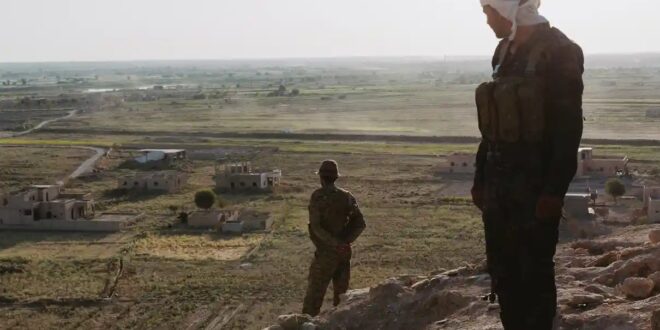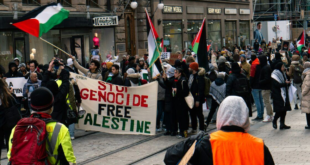From a ridge known locally as Baghouz Mountain, the most contested corner of the Middle East resembles an oasis: it’s a splash of green on a desert horizon stretching from the banks of the Euphrates to a sprawling area of new homes housing new – and unruly – neighbours.
Little moves in the heat of the day. The river that has sustained Iraq and eastern Syria through the ages comes alive at night, and so does the town of al-Bukamal, where smugglers, militia members, proxy groups, mercenaries and the armies of three nations have all taken prominent stakes since the juggernaut of Islamic State was defeated here three years ago.
The intervening tumult has left much of Deir ez-Zor province ravaged and unreconciled. Many residents are still missing or displaced, and the war against the terror group still simmers. On main highways, clapped-out tractors and tankers give way to passing convoys of US and Russian battle trucks. French and US attack helicopters crisscross the skies and coalition special forces still hold bases.
In al-Bukamal, the mix of players and the contest for influence is even more potent: Shia militias from Iraq, Iran and Lebanon – among them Hezbollah – as well as Russian mercenaries, Sunni tribesmen and the Syrian army, with Kurdish forces watching from across the river.
This border town has become the most strategic pocket of the region. Whoever secures passage here has a significant say in events on both sides of the Euphrates. “That’s why we’re here, watching the spectacle,” said a Kurdish officer on the ridge above Baghouz. “All that land in front of us will be fought over for years to come.”
In late August, the Kurds were woken at night by loud explosions in the middle distance. “We could hear the jets, but they weren’t there for long,” said another officer. “They were Israelis, we later learned. Their strikes are different from the American ones.”
Over the past three years, airstrikes have regularly hit al-Bukamal and its approaches, as well as the town of al-Qaim, just over the Iraqi border. The targets are sites linked to Iranian-backed militia groups, which use the town to move weaponry and money from Iraq into Syria. Al-Bukamal has become the main thoroughfare of a three-decades-old Iranian project aimed at securing an arc of influence from Iraq through Syria to the Mediterranean.
Establishing such access, which would also cement a bridgehead in Syria for Hezbollah – the Lebanese militia – was a strategic goal of Iranian general Qassem Suleimani and his ally Abu Mahdi al-Muhandis, who were both assassinated by a US airstrike in Baghdad in early 2020.
Iran’s plans to establish the corridor were first reported by the Observer in October 2016, and efforts have since intensified in the five years since – especially after the death of Suleimani. “The airstrikes are quite regular,” said the Kurdish officer. “They are very short and usually very damaging. Whoever it is knows what they want to hit.”
Five people were wounded in a suspected Israeli drone attack on the town on 8 October. A more significant strike on 21 September killed five. Back in January, dozens were killed by the most extensive attacks yet. “They never bother us,” the Kurdish soldier said, staring through binoculars towards a Syrian military position. “I’m not sure it bothers the Iranians either. Al-Bukamal is still very busy. There is a lot of smuggling through al-Qaim, and some of it crosses the river in boats.”
Residents of al-Bukamal say the town has changed significantly since Islamic State was ousted. “When the Shias moved in, there was just as much fear,” said labourer Khaled Sohail. “The Iranians have a lot of money to spend and have influenced the tribes. But they’re not the worst – it’s the Hashd al-Shadid [Popular Mobilisation Forces, raised in 2014 to fight Isis] who scare everyone. They’re Shia, and very sectarian.”
Three other al-Bukamal residents confirmed a belief held by European officials that an Iranian officer, who uses the nom de guerre Hajj Asker, is a significant figure. The militia he leads – Brigade 47 of Kata’ib Hezbollah, an Iraqi proxy loyal to Iran – holds sway in much of the town, but has alienated residents and tribal leaders.
Most local recruits to Brigade 47 are drawn from the Mashahada and Jughaifi tribes. “They are the ones who have sold the town to Iran,” said one Al-Bukamal resident. “And they did so cheaply. They are helping the smuggling. This won’t end well.”
‘Now I’ve a purpose’: why more Kurdish women are choosing to fight
Read more
“They are bringing their ways to the area,” said a second resident. “There are people praying like Shias. What is happening there is changing not just the region but the town itself. There are schools learning Persian history, and Shia religious leaders who have influence over the communities. They are more powerful than Bashar’s army, who stand by while Iran and its friends make their own plans.”
Across the Euphrates in Baghouz, where Isis made its last stand in early 2019, Kurdish officers from the US-backed Syrian Democratic Forces (SDF) patrol the banks, eyeing Syrian soldiers on the other half of a fallen bridge that used to connect the towns.
“Isis downed it to stop the others from attacking them,” said one of the officers, Agin Afrin. “Then they tried to build their own bridge.” He pointed at a pile of rocks halfway across the slow-moving water. “When the rains come the rest will wash away. We see the regime every day. They can do nothing on their side, or ours.”
Baghouz now bears silent witness to the struggle for influence playing out nearby. Farmers have returned, and crops of sunflowers shimmer in the evening breeze, sharing the riverbank with rows of pomegranate trees. The Kurds pass the fruits around as they trudge through long reeds. “Everyone has fought over this land,” said Afrin. “At least 5,000 Isis people died in the town behind us [Baghouz]. I often wonder why here. How did this part of the Middle East come to be so important in history? And what will it look like in two years?”
As the sun set over the Euphrates, men and women who had moved back to Baghouz tentatively approached to speak. “They attacked us from across the bridge,” said one man of Shia forces and the Syrian army in late 2018. “We were terrified of them and then came Isis. This land is cursed.”
One of the Kurdish officers added: “They think it’s their land, and others have a say in that including us. I don’t see an end to the fighting.”
 Eurasia Press & News
Eurasia Press & News


